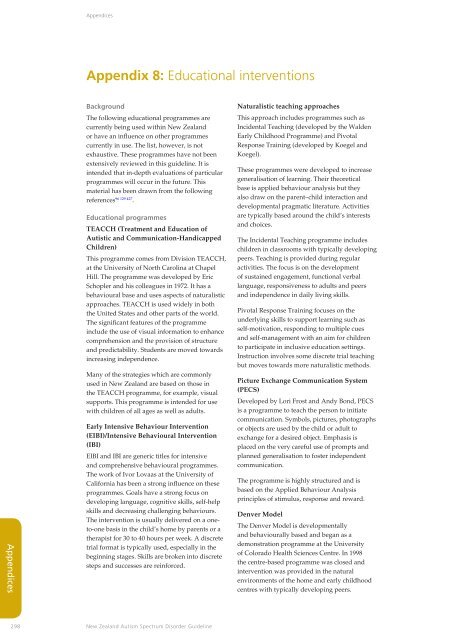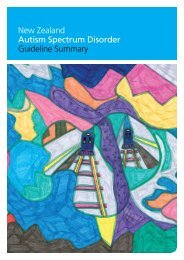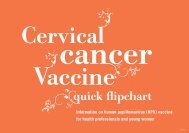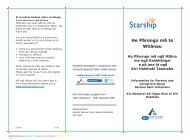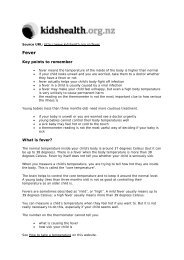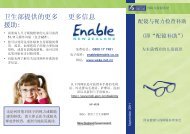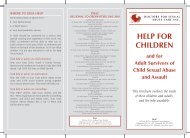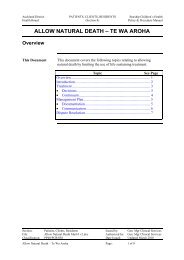New Zealand Autism Spectrum Disorder Guideline - Ministry of Health
New Zealand Autism Spectrum Disorder Guideline - Ministry of Health
New Zealand Autism Spectrum Disorder Guideline - Ministry of Health
You also want an ePaper? Increase the reach of your titles
YUMPU automatically turns print PDFs into web optimized ePapers that Google loves.
Appendices<br />
<br />
Appendix 8:Educational interventions<br />
Appendices<br />
Background<br />
The following educational programmes are<br />
currently being used within <strong>New</strong> <strong>Zealand</strong><br />
or have an influence on other programmes<br />
currently in use. The list, however, is not<br />
exhaustive. These programmes have not been<br />
extensively reviewed in this guideline. It is<br />
intended that in-depth evaluations <strong>of</strong> particular<br />
programmes will occur in the future. This<br />
material has been drawn from the following<br />
references 96 129 427 .<br />
Educational programmes<br />
TEACCH (Treatment and Education <strong>of</strong><br />
Autistic and Communication-Handicapped<br />
Children)<br />
This programme comes from Division TEACCH,<br />
at the University <strong>of</strong> North Carolina at Chapel<br />
Hill. The programme was developed by Eric<br />
Schopler and his colleagues in 1972. It has a<br />
behavioural base and uses aspects <strong>of</strong> naturalistic<br />
approaches. TEACCH is used widely in both<br />
the United States and other parts <strong>of</strong> the world.<br />
The significant features <strong>of</strong> the programme<br />
include the use <strong>of</strong> visual information to enhance<br />
comprehension and the provision <strong>of</strong> structure<br />
and predictability. Students are moved towards<br />
increasing independence.<br />
Many <strong>of</strong> the strategies which are commonly<br />
used in <strong>New</strong> <strong>Zealand</strong> are based on those in<br />
the TEACCH programme, for example, visual<br />
supports. This programme is intended for use<br />
with children <strong>of</strong> all ages as well as adults.<br />
Early Intensive Behaviour Intervention<br />
(EIBI)/Intensive Behavioural Intervention<br />
(IBI)<br />
EIBI and IBI are generic titles for intensive<br />
and comprehensive behavioural programmes.<br />
The work <strong>of</strong> Ivor Lovaas at the University <strong>of</strong><br />
California has been a strong influence on these<br />
programmes. Goals have a strong focus on<br />
developing language, cognitive skills, self-help<br />
skills and decreasing challenging behaviours.<br />
The intervention is usually delivered on a oneto-one<br />
basis in the child’s home by parents or a<br />
therapist for 30 to 40 hours per week. A discrete<br />
trial format is typically used, especially in the<br />
beginning stages. Skills are broken into discrete<br />
steps and successes are reinforced.<br />
Naturalistic teaching approaches<br />
This approach includes programmes such as<br />
Incidental Teaching (developed by the Walden<br />
Early Childhood Programme) and Pivotal<br />
Response Training (developed by Koegel and<br />
Koegel).<br />
These programmes were developed to increase<br />
generalisation <strong>of</strong> learning. Their theoretical<br />
base is applied behaviour analysis but they<br />
also draw on the parent–child interaction and<br />
developmental pragmatic literature. Activities<br />
are typically based around the child’s interests<br />
and choices.<br />
The Incidental Teaching programme includes<br />
children in classrooms with typically developing<br />
peers. Teaching is provided during regular<br />
activities. The focus is on the development<br />
<strong>of</strong> sustained engagement, functional verbal<br />
language, responsiveness to adults and peers<br />
and independence in daily living skills.<br />
Pivotal Response Training focuses on the<br />
underlying skills to support learning such as<br />
self-motivation, responding to multiple cues<br />
and self-management with an aim for children<br />
to participate in inclusive education settings.<br />
Instruction involves some discrete trial teaching<br />
but moves towards more naturalistic methods.<br />
Picture Exchange Communication System<br />
(PECS)<br />
Developed by Lori Frost and Andy Bond, PECS<br />
is a programme to teach the person to initiate<br />
communication. Symbols, pictures, photographs<br />
or objects are used by the child or adult to<br />
exchange for a desired object. Emphasis is<br />
placed on the very careful use <strong>of</strong> prompts and<br />
planned generalisation to foster independent<br />
communication.<br />
The programme is highly structured and is<br />
based on the Applied Behaviour Analysis<br />
principles <strong>of</strong> stimulus, response and reward.<br />
Denver Model<br />
The Denver Model is developmentally<br />
and behaviourally based and began as a<br />
demonstration programme at the University<br />
<strong>of</strong> Colorado <strong>Health</strong> Sciences Centre. In 1998<br />
the centre-based programme was closed and<br />
intervention was provided in the natural<br />
environments <strong>of</strong> the home and early childhood<br />
centres with typically developing peers.<br />
298<br />
<strong>New</strong> <strong>Zealand</strong> <strong>Autism</strong> <strong>Spectrum</strong> <strong>Disorder</strong> <strong>Guideline</strong>


